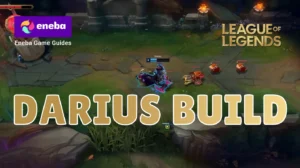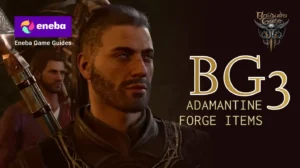How to Beat 99 Nights in the Forest: Survive Cultists, Deer, and the Dark
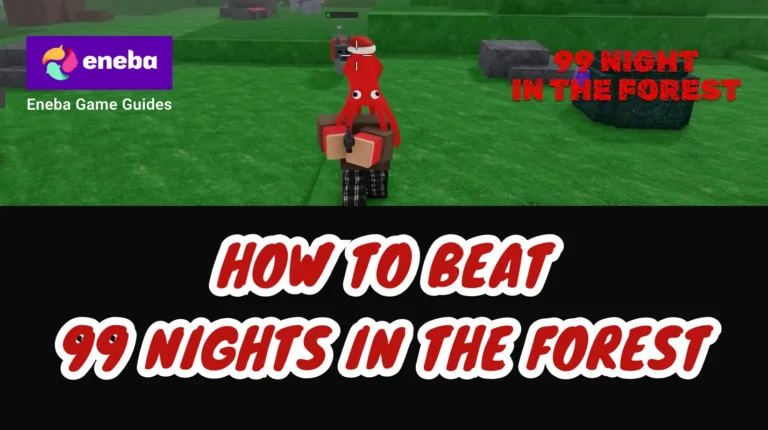
To learn how to beat 99 Nights in the Forest, you need calm hands and clear priorities. Cultists press you, creatures stalk the treeline, and the map punishes wasted motion while you juggle light, a base, and four missing kids.
This guide trims the noise. I’ll just cover what matters, when to push, and the mistakes that burn runs. Read on and turn the dark from panic to progress.
Jump to:
Choosing a Class and Planning Your Run
Selecting a character class is your first decision in 99 Nights in the Forest. Each class comes with different starting equipment and upgrade potential, but don’t let fancy gear distract you.
Many two and three‑star classes are perfectly viable. When I started, the Scavenger was my go‑to because it offers extra backpack space for only 25 diamonds. That extra storage makes a huge difference when gathering wood, coal, and early materials. If you’re drawn to combat roles, the Hunter gives you a rifle but lacks inventory space, so be ready to manage items carefully.
Diamonds are a premium currency, and the game regularly releases codes that award free diamonds or special badges. Redeem these codes as soon as you find them and save the currency for class upgrades rather than impulse purchases.
Our 7 Days to Die tips article explains why learning systems first always beats spending resources blindly. The same philosophy applies here: get comfortable with your chosen class, complete early challenges, and only then consider investing in a more expensive class or talent re‑roll.
Feed the Fire and Explore Early
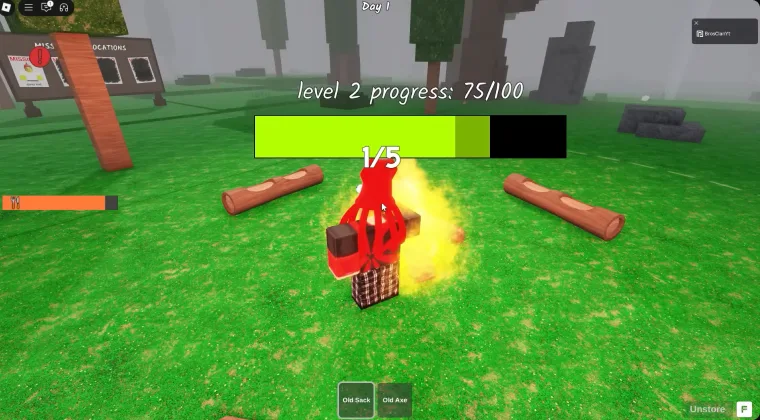
Once you load into the forest, a timer starts counting down to the first night. The Deer Monster and other horrors only appear after dark, so make the most of daylight. Chop down a couple of trees and immediately add wood to your campfire.
A burning fire creates a protective circle that keeps the Deer at bay and also reveals nearby map areas. After fueling the fire, venture out to the nearest building. The early buildings contain chests with useful items like coal, wooden chairs (excellent fuel), and sometimes weapons.
During my first successful run, I prioritized getting the Good Axe and Good Sack. To obtain these, hunt rabbits on day one to collect a Rabbit’s Foot. The Pelt Trader appears on day two and will trade a Rabbit’s Foot for either the Good Axe (faster chopping), Good Sack (larger backpack), or Old Flashlight.
In my experience, the Good Axe is the best first purchase; it speeds up wood collection and acts as a backup weapon when you haven’t found a spear or rifle yet. If you play with friends, have one teammate grab the Good Sack to carry extra fuel and crafting materials. Once you have a decent axe and sack, continue exploring buildings for coal, gasoline, weapons, and medkits. These early resources set you up for the long haul.
Build and Upgrade Your Base
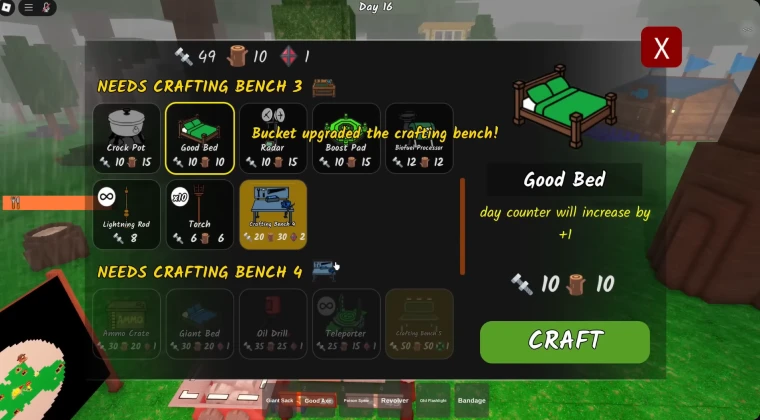
A sturdy base is essential for beating 99 nights. Your initial crafting bench allows basic items like a Map and Farm Plot. Crafting a map costs just three pieces of wood, and it becomes accessible anywhere by pressing M. This navigation tool is invaluable for locating children, caves, and your way back to camp. Beds are another early priority; each bed you build adds +1 to the day counter, essentially letting you skip ahead. Build an Old Bed early and upgrade it whenever possible.
Once your bench reaches tier two, focus on tools that improve efficiency. Wood Rain Storage keeps your fuel dry during storms, while Wood Storage lets you stack more wood without cluttering your inventory.
Upgrading the bench unlocks tier three and four gear like the Biofuel Processor and Lightning Rod. The processor converts food and wood into high‑value fuel, perfect for keeping the fire burning when resources grow scarce. The lightning rod protects your camp from random storms that could extinguish the fire. These structures may feel like luxuries at first, but they prevent mid‑game disasters.
Tree management is equally important. After cutting a tree, always plant the sapling it drops. Replanting trees around the campfire creates a natural barrier against cultist attacks and ensures you never run out of wood. I learned the hard way that a barren camp means longer runs to gather fuel. A ring of saplings also slows enemy movement, giving you more time to react. For more ideas on smart base design, our Project Zomboid tips guide discusses barricades and choke points that translate well to forest survival.
Manage Resources and Craft Essentials
Surviving 99 nights means managing wood, food, medical supplies, and crafting materials. Wood serves as both fuel and building material, so don’t burn every log you collect. Coal and gasoline are far more efficient for fueling the fire; save wood for building benches, beds, and storage. Food never spoils in 99 Nights in the Forest, which allows you to cook in bulk and stockpile meals for later. Take advantage by roasting meat whenever you have downtime, then store it for emergencies.
Medical supplies are crucial because enemy attacks grow stronger with each night. You can craft bandages once you find the Anvil, but the material cost increases after each craft. Use bandages sparingly to revive fallen teammates; save medkits for serious injuries. If you play solo, keep a medkit on your hot bar in case a cultist ambush catches you off‑guard.
Pelts and amulets also play an important role. Pelts drop from cave guardians like wolves and bears. Besides trading pelts for gear upgrades with the Pelt Trader, you can craft armor that reduces damage from cultists. Amulets drop from cultist attackers and are necessary for advanced recipes. By day 10 or so, you should have a small stash of pelts and amulets. Resist the urge to craft everything right away; instead, check your current needs and plan for upcoming threats.
Deal with Threats: Deer, Owl, Ram and Cultists
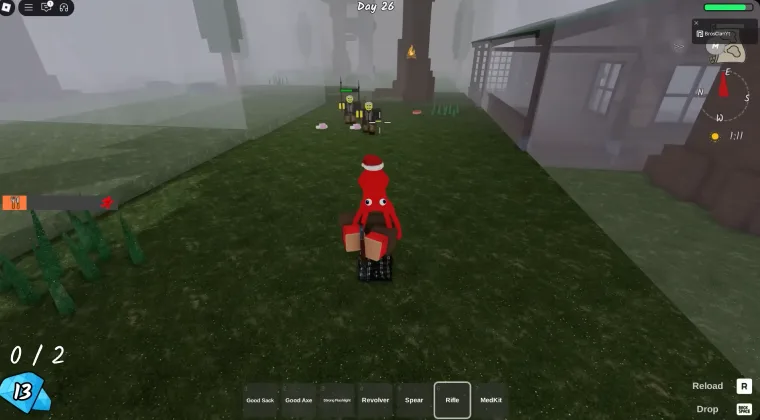
Nighttime brings a mix of creatures, each requiring a different approach. The Deer Monster is invulnerable and appears as soon as darkness falls. It will not cross your campfire’s protective circle, so never let the fire go out. Outside of that circle, your only defense is your flashlight. Shine the beam directly at the Deer to make it retreat temporarily. If you venture away from camp at night, always carry spare batteries or an extra flashlight, and keep sprinting to outrun the beast. Should it catch you, the Deer deals heavy damage but doesn’t kill instantly, giving you a chance to escape.
The Owl appears around the fifth night. Unlike the Deer, it can swoop in quickly and stun you. You can’t kill the Owl, but a flashlight will momentarily freeze it. If you haven’t found a flashlight yet, stay near the campfire when the Owl is active. Later updates introduced the Ram, a charging creature that inhabits the volcano biome. When the Ram charges, run diagonally and place obstacles (trees, rocks, or structures) between you and the beast. The Ram destroys anything it hits, so lure it away from your camp to avoid collateral damage. Keep in mind that the Ram may rotate in and out of the enemy pool depending on updates.
Cultists attack every three nights and become more aggressive over time. Prioritize killing ranged cultists first, as their crossbows can take you down from a distance. Use bear traps to slow melee attackers and funnel them into kill zones. When possible, build fences or strategically placed trees to create choke points. Cultists drop amulets, so collect them after each raid.
Caves containing missing children are guarded by wolves or bears, and defeating these guardians yields keys to rescue the children. Coordinate with your team, use long‑range weapons to kite the animals, and have someone ready with a bandage in case things go wrong.
Rescue the Children and Accelerate Time
Finding and rescuing the four missing children is critical to beating the game faster. Each child you save provides a significant time bonus that skips multiple nights. Use your map and compass to navigate the forest efficiently. The children are hidden in various biomes, often behind locked caves that require keys from cave guardians. Bring weapons, healing supplies, and extra fuel before venturing far from camp.
Once you rescue a child, escort them back to your camp. The game lets you build beds for each child, and sleeping through the night with them safely in bed accelerates the day counter. By combining rescued children with upgraded beds, you can skip large chunks of the 99 nights and reduce the total time spent in danger.
Late‑game progression revolves around maximizing efficiency. Once you have a biofuel processor, lightning rod, and teleporters, focus on Echo crafting to imbue your weapons and tools with supernatural effects. Echoes add elemental damage or defensive buffs, making encounters with cultists and guardians more manageable.
Build an Ammo Crate to ensure you never run out of bullets when things get hectic. The dynamic fear system means your character’s sanity will waver; keep lights on and avoid spending too much time in the dark to manage fear levels. Above all, pace yourself. The early nights can feel slow, but patience and preparation pay off as the difficulty spikes.
My Takeaway and Final Thoughts
After dozens of runs, the biggest lesson I learned about how to beat 99 Nights in the Forest is that preparation trumps heroics. Focus on your campfire, plan your upgrades, and always have a light source.
Don’t neglect resource management; burning all your wood on day one leaves you scrambling later. And remember that every new tool and structure should solve a problem, not just look cool. Survival games reward planning over impulsiveness, and 99 Nights in the Forest is no exception.
When you’re ready to dive back into the forest, grab a Roblox Gift Card from our store to pick up cosmetics or upgrade your experience. Each step you take toward efficiency brings you closer to conquering all 99 nights.
FAQs
How do you survive 99 Nights in the Forest?
To survive 99 Nights in the Forest, focus on keeping your campfire lit, gathering fuel and resources during the day, and building beds and a map early on. Rescuing missing children and upgrading your bench accelerate time, letting you skip nights and reduce overall danger.
What is the best class in 99 Nights in the Forest?
The best class in 99 Nights in the Forest depends on your playstyle, but many players start with the Scavenger because it offers extra inventory space for a low diamond cost. Once you understand the mechanics, you can invest in higher‑star classes that emphasize combat or support skills.
How do you get diamonds in 99 Nights in the Forest?
To get diamonds in 99 Nights in the Forest, redeem promotional codes released by the developers and earn badges through achievements like saving children and surviving specific events. Over time, you’ll accumulate enough diamonds to upgrade your class or purchase cosmetic items.
How do you get the Good Axe in 99 Nights in the Forest?
To get the Good Axe in 99 Nights in the Forest, hunt rabbits early on to obtain a Rabbit’s Foot and trade it with the Pelt Trader on day two. The Pelt Trader offers a choice between the Good Axe, Good Sack, and Old Flashlight; the Good Axe is often the most useful first upgrade.
How do you speed up time in 99 Nights in the Forest?
To speed up time in 99 Nights in the Forest, build beds and rescue missing children. Each bed you construct adds +1 to the day counter, and each rescued child grants a significant time bonus. Sleeping at night with these bonuses skips multiple nights, helping you reach the end faster.




